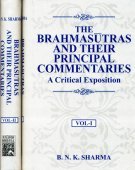Varnashrama, Varṇāśrama, Varna-ashrama, Varṇāśramā: 16 definitions
Introduction:
Varnashrama means something in Hinduism, Sanskrit, Marathi, Hindi. If you want to know the exact meaning, history, etymology or English translation of this term then check out the descriptions on this page. Add your comment or reference to a book if you want to contribute to this summary article.
The Sanskrit terms Varṇāśrama and Varṇāśramā can be transliterated into English as Varnasrama or Varnashrama, using the IAST transliteration scheme (?).
In Hinduism
Purana and Itihasa (epic history)
Source: archive.org: Shiva Purana - English TranslationVarṇāśrama (वर्णाश्रम) refers to the “system of varṇas and āśramas ”, as explained in the Śivapurāṇa 2.2.23. Accordingly as Brahmā narrated to Nārada:—“[...] on hearing the enquiry of Satī Śiva was delighted and He narrated them with pleasure in their entirety for raising the worldly creatures. [...] The duties of sons, wives etc. and their greatness, the imperishable (anaśvara) system of Varṇas and Āśramas (viz., varṇāśrama), the medical lore, and the astral lore, all beneficent to worldly creatures were explained by him”.
Note: Varṇāśrama refers to the “laws relating to four castes”—Brāhmaṇa, Kṣatriya, Vaiśya and Śūdra and to four stages of life—the student, the householder, the anchorite and the religious mendicant are expounded in the code of Manu and are applicable to Indian Society alone.
Source: Cologne Digital Sanskrit Dictionaries: The Purana IndexVarṇāśrama (वर्णाश्रम).—Social polity;1 truth, charity and selfcontrol are equal to tīrthas for homekeepers;2 Yayāti speaks of four Varṇas born of one body and their respective duties of whom the Brāhmaṇa is superior;3 lost in a period of anarchy;4 in the Śākadvīpa;5 said by Manu;6 restrictions get loosened in Dvāpara;7 disappearance of, in Kali;8 (see Varṇa dharma). In Tretā Kṣatriyas followed the Brāhmaṇas, the Vaiśyas the Kṣatriyas and the Śūdras the Vaiśyas; there was thus peace everywhere and everything bore fruit;9 leads to enjoyment in heaven;10 no such system in Kṛtayuga.11
- 1) Matsya-purāṇa 2. 23; Vāyu-purāṇa 61. 97.
- 2) Brahmāṇḍa-purāṇa II. 14. 41-2. Matsya-purāṇa 22. 80.
- 3) Ib. 30. 20.
- 4) Ib. 47. 257.
- 5) Ib. 122. 38.
- 6) Ib. 123. 23; 142. 42.
- 7) Ib. 142. 53; 143. 4; 144. 6 and 26.
- 8) Ib. 144. 96; 215. 63; 273. 32 and 46. Viṣṇu-purāṇa VI. 1. 10, 32-3.
- 9) Vāyu-purāṇa 30. 294; 49. 117; 57. 52.
- 10) Ib. 59. 22 and 36; 99. 425; 101. 6. 137 and 174; 102, 70 and 96; 104. 21.
- 11) Brahmāṇḍa-purāṇa II. 7. 55.

The Purana (पुराण, purāṇas) refers to Sanskrit literature preserving ancient India’s vast cultural history, including historical legends, religious ceremonies, various arts and sciences. The eighteen mahapuranas total over 400,000 shlokas (metrical couplets) and date to at least several centuries BCE.
Vaishnavism (Vaishava dharma)
Source: Prabhupada Books: Sri Caitanya CaritamrtaVarṇāśrama (वर्णाश्रम).—Every man should perform his occupational duty in the light of his particular tendency. According to his abilities, one should accept a position in the varṇāśrama institution. The divisions of brāhmaṇa, kṣatriya, vaiśya and śūdra are natural divisions within society. Indeed, everyone has a prescribed duty according to the varṇāśrama-dharma. Those who properly execute their prescribed duties live peacefully and are not disturbed by material conditions.
The Lord has said that the varṇāśrama-dharma is not properly executed in this Age of Kali; therefore He ordered Rāmānanda Rāya to go further into the matter. Rāmānanda replied with this verse from the Bhagavad-gītā (9.27), which instructs that while remaining in the system of varṇāśrama-dharma one may offer the results of his activities to Lord Śrī Kṛṣṇa in loving service. Naturally Lord Śrī Caitanya Mahāprabhu was asking Rāmānanda Rāya about the execution of devotional service.
Source: Pure Bhakti: Bhajana-rahasya - 2nd EditionVarṇāśrama (वर्णाश्रम) refers to:—The Vedic social system, which organises society into four occupational divisions and four stages of life (varṇas and āśramas). (cf. Glossary page from Bhajana-Rahasya).

Vaishnava (वैष्णव, vaiṣṇava) or vaishnavism (vaiṣṇavism) represents a tradition of Hinduism worshipping Vishnu as the supreme Lord. Similar to the Shaktism and Shaivism traditions, Vaishnavism also developed as an individual movement, famous for its exposition of the dashavatara (‘ten avatars of Vishnu’).
Dharmashastra (religious law)
Source: Shodhganga: The saurapurana - a critical study (dharma)Varṇāśrama (वर्णाश्रम) refers to the laws related to the “four castes and four orders”, according to the 10th century Saurapurāṇa: one of the various Upapurāṇas depicting Śaivism.—The performance of varṇāśrama-dharma is said to be elevating and productive of happiness both in this world and the next. And the violation of it leads to misery or suffering in hell. In the Saurapurāṇa (chapter 17) the sages ask the Sūta to narrate the varṇāśrama-dharma. Then the Sūta narrates it as it was told by the Sun-god to Manu.
Four varṇas:—In ancient India the society was divided into four principal castes, namely Brāhmaṇa, Kṣatriya, Vaiśya and Śūdra; and the dharmaśāstras employ the term varṇa to designate these castes.
Four āśramas: The word āśrama is derived from śram to exert, to labour, and etymologically means to a stage in which one exerts oneself. From the times of the most ancient dharmaśāstras the number of āśramas has been four:—Brahmacarya, Gṛhastha, Vānaprastha and Sannyāsin

Dharmashastra (धर्मशास्त्र, dharmaśāstra) contains the instructions (shastra) regarding religious conduct of livelihood (dharma), ceremonies, jurisprudence (study of law) and more. It is categorized as smriti, an important and authoritative selection of books dealing with the Hindu lifestyle.
Yoga (school of philosophy)
Source: ORA: Amanaska (king of all yogas): A Critical Edition and Annotated Translation by Jason BirchVarṇāśrama (वर्णाश्रम) refers to “one’s caste-class and religious disciplines”, according to the Sarvajñānottara verse 20.34-39.—Accordingly, while discussing the culmination of detachment (for the process of attaining the no-mind state): “Having abandoned those feelings connected with his region, caste, his caste-class and religious disciplines (varṇāśrama), the wise should meditate on his own [inner] state. Abandoning all such feelings as ‘this is [my] mantra’, ‘this is [my] deity’, ‘this is [my] meditation’ [or] ‘this is [my] austerity’, he should meditate on his own [inner] state. [...]”.

Yoga is originally considered a branch of Hindu philosophy (astika), but both ancient and modern Yoga combine the physical, mental and spiritual. Yoga teaches various physical techniques also known as āsanas (postures), used for various purposes (eg., meditation, contemplation, relaxation).
Shaktism (Shakta philosophy)
Source: ORA: Amanaska (king of all yogas): (shaktism)Varṇāśrama (वर्णाश्रम) refers to “caste and religious duties”, according to the 17th century Kaulagajamardana (“crushing the Kaula elephant”) authored by Kāśīnātha or Kṛṣṇānandācala.—Accordingly, [as Īśvara said to Pārvatī]: “Listen, O Pārvatī, I shall give a critique of the Pāṣaṇḍas. Knowing this, a wise man is not defeated by them. Those devoted to fake observances; those who rebuke the religion of the Vedas; those who have fallen from caste and religious duties (varṇāśrama); those who have erred and think themselves learned, they are [all] called Pāṣaṇḍas [because] they act contrary to [true] religion. They fall into a terrifying hell until the end of the world. [...]”

Shakta (शाक्त, śākta) or Shaktism (śāktism) represents a tradition of Hinduism where the Goddess (Devi) is revered and worshipped. Shakta literature includes a range of scriptures, including various Agamas and Tantras, although its roots may be traced back to the Vedas.
Languages of India and abroad
Marathi-English dictionary
Source: DDSA: The Molesworth Marathi and English Dictionaryvarṇāśrama (वर्णाश्रम).—m pl S The four varṇa (grand divisions of the Hindu body) and the four āśrama (orders or stages of the Brahman).
Source: DDSA: The Aryabhusan school dictionary, Marathi-Englishvarṇāśrama (वर्णाश्रम).—m pl The four varṇa castes and the four āśrama orders.
Marathi is an Indo-European language having over 70 million native speakers people in (predominantly) Maharashtra India. Marathi, like many other Indo-Aryan languages, evolved from early forms of Prakrit, which itself is a subset of Sanskrit, one of the most ancient languages of the world.
Sanskrit dictionary
Source: DDSA: The practical Sanskrit-English dictionaryVarṇāśramā (वर्णाश्रमा).—the (four) castes and stages of life; वर्णाश्रमाणां गुरवे स वर्णी विचक्षणः प्रस्तुतमाचचक्षे (varṇāśramāṇāṃ gurave sa varṇī vicakṣaṇaḥ prastutamācacakṣe) R.5.19. °गुरुः (guruḥ) Name of Śiva. °धर्मः (dharmaḥ) the duties of caste and order.
Derivable forms: varṇāśramāḥ (वर्णाश्रमाः).
Varṇāśramā is a Sanskrit compound consisting of the terms varṇa and āśramā (आश्रमा).
Source: Cologne Digital Sanskrit Dictionaries: Shabda-Sagara Sanskrit-English DictionaryVarṇāśrama (वर्णाश्रम).—n.
(-maṃ) The class and state of a person. E. varṇa and āśrama order.
Source: Cologne Digital Sanskrit Dictionaries: Cappeller Sanskrit-English DictionaryVarṇāśrama (वर्णाश्रम).—[masculine] [plural] caste and order (cf. āśama).
Source: Cologne Digital Sanskrit Dictionaries: Monier-Williams Sanskrit-English DictionaryVarṇāśrama (वर्णाश्रम):—[from varṇa > varṇ] n. caste and order, class and stage of life (See āśrama), [Śakuntalā]
Source: Cologne Digital Sanskrit Dictionaries: Yates Sanskrit-English DictionaryVarṇāśrama (वर्णाश्रम):—[varṇā+śrama] (maṃ) 1. n. Station in society.
Sanskrit, also spelled संस्कृतम् (saṃskṛtam), is an ancient language of India commonly seen as the grandmother of the Indo-European language family (even English!). Closely allied with Prakrit and Pali, Sanskrit is more exhaustive in both grammar and terms and has the most extensive collection of literature in the world, greatly surpassing its sister-languages Greek and Latin.
Hindi dictionary
Source: DDSA: A practical Hindi-English dictionaryVarṇāśrama (वर्णाश्रम):—(nm) the caste and the stage of life i.e. [āśrama; -dharma] duties related to the caste and the stage of life ([āśrama]).
...
Kannada-English dictionary
Source: Alar: Kannada-English corpusVarṇāśrama (ವರ್ಣಾಶ್ರಮ):—
1) [noun] a following of traditional occupation and observance that are particular to each of the four casses of HIndu society.
2) [noun] the four stages in the life of a brāhmaṇa, they being brahmacarya (studentship), gārhasthya (householdership), vānaprstha (a living a secluded in the forest), and Sanyāsa (a state of being relieved from all worldly connections and passions and being a monk).
Kannada is a Dravidian language (as opposed to the Indo-European language family) mainly spoken in the southwestern region of India.
See also (Relevant definitions)
Partial matches: Varna, Ashrama.
Starts with: Varnashramacara, Varnashramadharma, Varnashramadharmadipa, Varnashramadharmadipika, Varnashramadipa, Varnashramagharmma, Varnashramaguru, Varnashramavant, Varnashramavat, Varnashramavyavasthe.
Full-text (+21): Varnashramadharma, Kshatriya, Brahmana, Vaishya, Dharma, Shudra, Varnashramavyavasthe, Varnashramavant, Varnashramadipa, Varnashramavat, Varunacciramatarmam, Varnashramaguru, Varnashramagharmma, Varnashramin, Grihastha, Brahmacarya, Brahmacari, Tamasivritti, Vanaprastha, Sannyasi.
Relevant text
Search found 53 books and stories containing Varnashrama, Varṇāśrama, Varna-ashrama, Varnasrama, Varṇa-āśrama, Varna-asrama, Varṇāśramā, Varṇa-āśramā; (plurals include: Varnashramas, Varṇāśramas, ashramas, Varnasramas, āśramas, asramas, Varṇāśramās, āśramās). You can also click to the full overview containing English textual excerpts. Below are direct links for the most relevant articles:
Song 40 < [Daṇḍa-bhaṅga-līlā (Pastime of Breaking the Daṇḍa)]
Song 6 < [Grantharambha (the book begins)]
Song 11 < [Grantharambha (the book begins)]
The Brihaddharma Purana (abridged) (by Syama Charan Banerji)
The Gita’s Ethics (A Critical Study) (by Arpita Chakraborty)
3. The Vedas < [Chapter 1 - Indian Ethics]
2. The word dharma used in the Gita < [Chapter 3 - Constituents of Moral Action: Dharma]
7. Co-relation of Varna-dharma with Sadharana and Svadharma < [Chapter 3 - Constituents of Moral Action: Dharma]
Temples in and around Madurantakam (by B. Mekala)
The Kshatriyas < [Chapter 6 - Social and Economic Activities]
Social life and Communities of the Madurantaka region < [Chapter 6 - Social and Economic Activities]
Pallava period (Social and Cultural History) (by S. Krishnamurthy)
Professional groups < [Chapter 3 - Socio-Religious Life]
The Later or the Imperial Pallavas < [Chapter 1 - Introduction]
Chaitanya Bhagavata (by Bhumipati Dāsa)
Verse 2.13.8 < [Chapter 13 - The Deliverance of Jagāi and Mādhāi]
Verse 1.13.52 < [Chapter 13 - Defeating Digvijayī]
Verse 1.14.14 < [Chapter 14 - The Lord’s Travel to East Bengal and the Disappearance of Lakṣmīpriyā]
Related products


